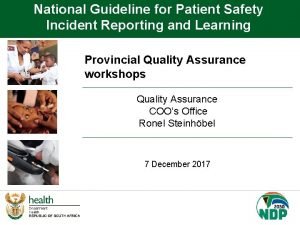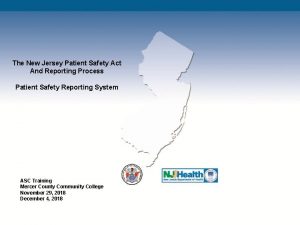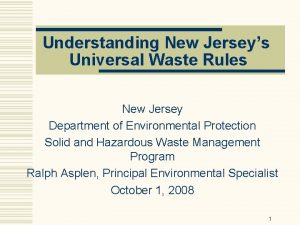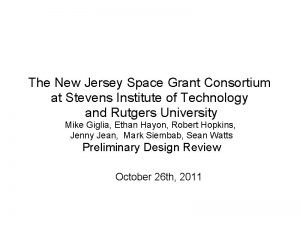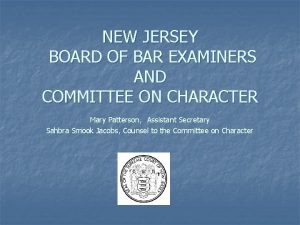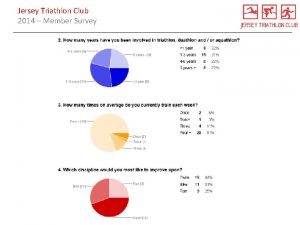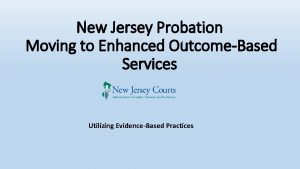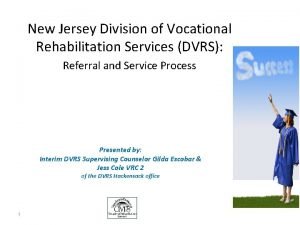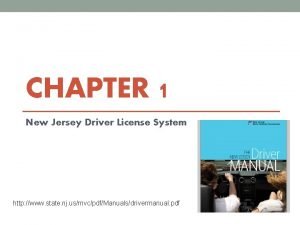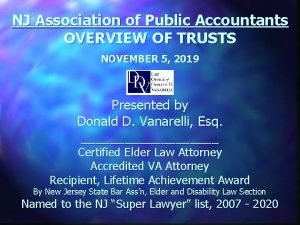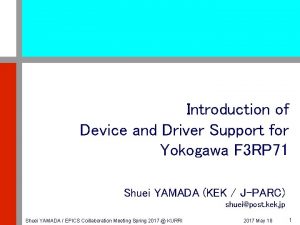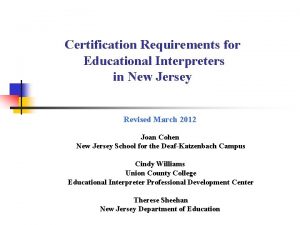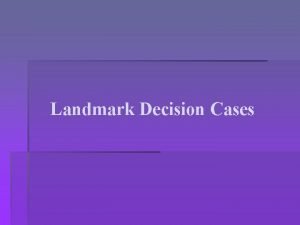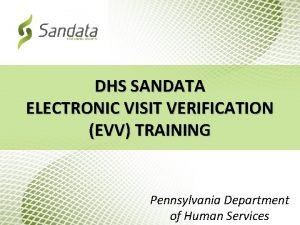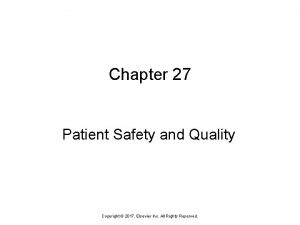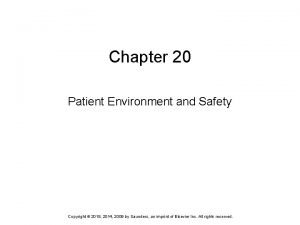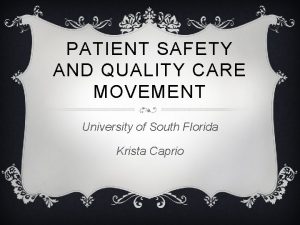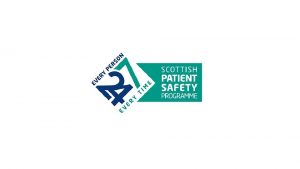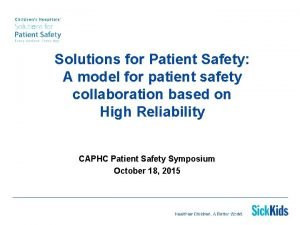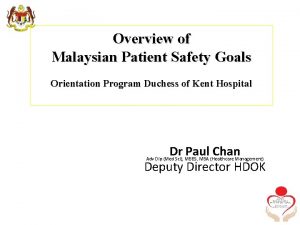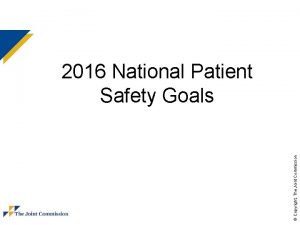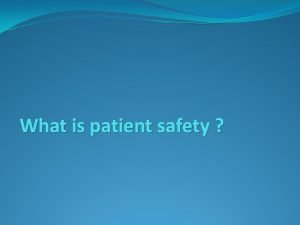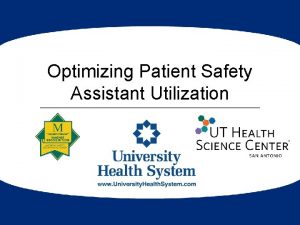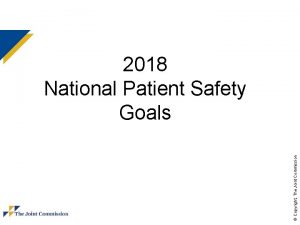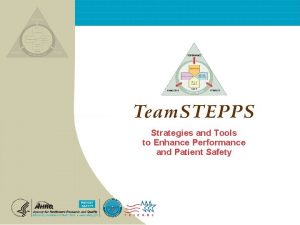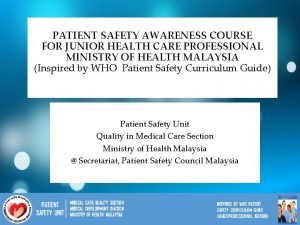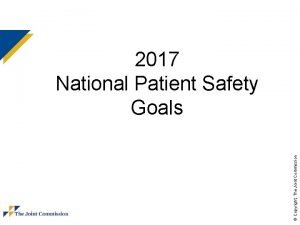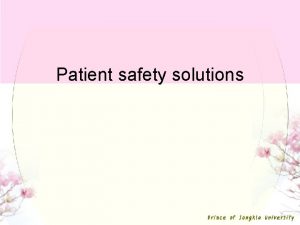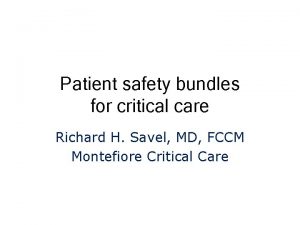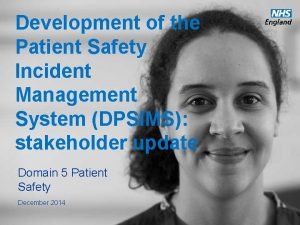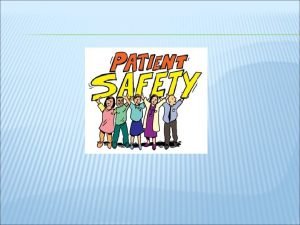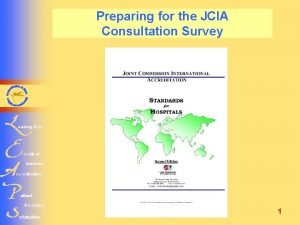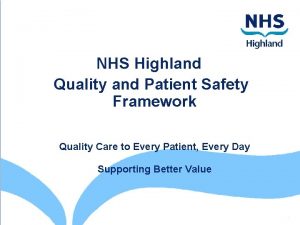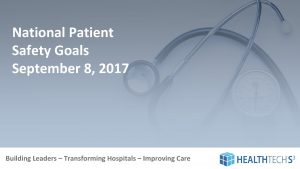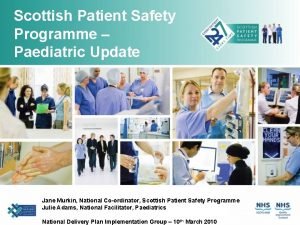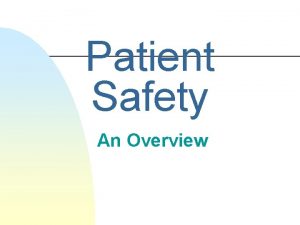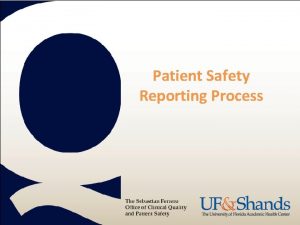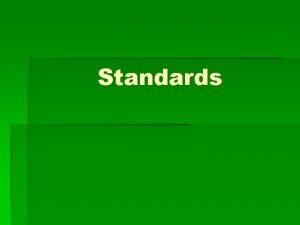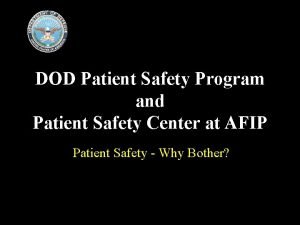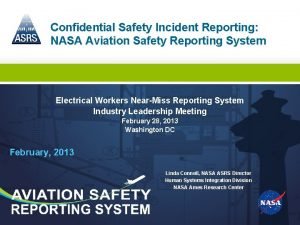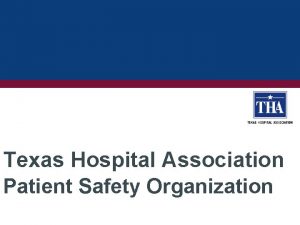The New Jersey Patient Safety Act And Reporting







































































- Slides: 71

The New Jersey Patient Safety Act And Reporting Process Patient Safety Reporting System ASC Training Mercer County Community College November 29, 2018 December 4, 2018

Patient Safety Reporting System The Presentation will Review 1. Patient Safety Act and Reporting Requirements 2. Adverse Event Reporting Process 3. Root Cause Analysis Reporting Process 4. New Facility User Registration Process 2

1. The Patient Safety Act and Reporting Requirements The Patient Safety Act (C. 26: 2 H-12. 23*) Enacted in April 2004 3 • Enhance Patient Safety • Minimize Number of Adverse Events • Minimize Patient Harm • Improve System/Facility Performance * Link available on the NJ Patient Safety website

1. The Patient Safety Act and Reporting Requirements Patient Safety Act continued • Confidentiality Protection • Encourages honest, critical self-analysis • Restricts • • • Discoverability Admissibility Disclosure of documents, materials and information • Be clear about separation between Patient Safety and Quality Improvement activities 4

1. The Patient Safety Act and Reporting Requirements Patient Safety Act continued • 5 Promotes a culture of safety • • • Encourages change and improvement Blame-free environment Collaboration between all levels and disciplines of staff Strive for “Zero” adverse events, not just better than the national average Commit resources to improvement

1. The Patient Safety Act and Reporting Requirements Patient Safety Act continued • Non-Punitive • No public reports are issued by PSRS that list individual facilities • Encourages evidence-based practices • Collegial 6

1. The Patient Safety Act and Reporting Requirements Patient Safety Act continued NJ Licensed healthcare facilities (including one room ASCs) must report every serious preventable adverse event • • • 7 A negative consequence of care that results in unintended injury or illness Discrete, auditable and clearly defined occurrence Preventable: an event that could have been anticipated and prepared against, but occurs because of an error or other system failure. • Frequently unable to make this determination at time of event Results in death or loss of a body part, or disability or loss of bodily function • Some event types have no threshold of injury such as RFOs, Wrong Surgery Lasts more than 7 days or present at discharge

1. The Patient Safety Act and Reporting Requirements Patient Safety Regulations (N. J. A. C. 8: 43 E-10*) requires facilities to**: • • Establish a Patient Safety Committee • Conduct ongoing analysis and application of evidence-based patient safety practices • Conduct analyses of near-misses, with particular attention to serious preventable adverse events Develop a Patient Safety Plan • Review and revise plan as necessary, at least every 3 -years • Foster attitudes, beliefs and behaviors supporting open communication in the facility • Review results of each RCA and, as appropriate, recommend modifications of systems, technology, policies or procedures * Link available on the NJ Patient Safety website ** List is not inclusive 8

1. The Patient Safety Act and Reporting Requirements Patient Safety Regulations continued • Report Serious Preventable Adverse Events that occur in the facility to DOH or DHS • If a facility discovers an event subject to mandatory reporting that occurred in a different facility, the discovering facility shall notify DOH but does not need to perform an RCA • The identity of the facility at which the event occurred should be reported to DOH if known 9 • Conduct Root Cause Analyses (RCAs) of Serious Preventable Adverse Events • Submit Root Cause Analyses of Serious Preventable Adverse Events to DOH or DHS

1. The Patient Safety Act and Reporting Requirements. Patient Safety Regulations continued • Disclose the Serious Preventable Adverse Event to the Patient or Health Care Representative within 24 hours of discovery • Record the time, date, and individuals present when disclosure was made and to whom it was disclosed in the medical record • Record a statement that the occurrence of a serious preventable adverse event was disclosed in the medical record • 10 Inform employees/health care professionals about their option to file anonymous reports of preventable adverse events

1. The Patient Safety Act and Reporting Requirements Patient Safety Regulations continued Event Report must be submitted into the online Patient Safety Reporting System no later than 5 business days after discovery 11 • The date and time of discovery is the date and time anyone associated with the ASC (including the physician) becomes aware of a serious preventable adverse event • The physician or surgeon is a member of the healthcare team.

1. The Patient Safety Act and Reporting Requirements Patient Safety Regulations continued • • 12 PSRS reviews event report in online system • PSRS determines whether a Root Cause Analysis (RCA) is required based on the rules and regulations and notifies the facility If the event is reportable, the RCA must be submitted to PSRS within 45 calendar days from initial event report

2. Adverse Event Reporting Process Reporting Categories* 13 • Care Management • Environmental • Product or Device • Surgery-Related • Patient Protection * List of reportable events are located in the Patient Safety Regulations

2. Adverse Event Reporting Process Surgery-Related Events • Wrong Surgery (wrong site, procedure, patient) • Surgery initiated (whether or not completed) on a patient that is not consistent with the patient’s documented informed consent • Wrong site • Wrong procedure • Wrong patient • Retention of a Foreign Object • Excludes objects intentionally implanted as a part of a planned procedure, objects present prior to the procedure intentionally retained and retained broken microneedles 14

2. Adverse Event Reporting Process Surgery-Related Events continued • Surgical—Intra/Post-op Coma/Death/Other • • • 15 Includes cases where anesthesia was administered regardless of whether the planned procedure was carried out Includes cases where adverse events occur within 24 hours of the procedure in any patient of an ambulatory surgery facility Surgical—Other • Generally used for any other surgical event that does not fit into the previous surgical event categories

2. Adverse Event Reporting Process Other Indicators of Reportable Events • Unplanned hospital admission • Visit to ED or other healthcare facility (e. g. , Urgent Care Center) following discharge from ASC • Intra/Post operative complications not limited to • • • 16 Aspiration Pneumothorax Organ Perforation Moderate to severe bleeding Serious infections

2. Adverse Event Reporting Process Threshold of Injury • Some event types have no threshold of injury such as • Retained Foreign Object • Wrong Site, Wrong procedure, Wrong patient • Most event types have a “threshold of injury” requirement in the regulations • Coma, death, loss of body part, disability or loss of bodily function lasting more than seven days or still present at discharge 17

2. Adverse Event Reporting Process Threshold of Injury continued 18 • Important for PSRS to determine if the event meets the “threshold of injury” when deciding whether the event will require an RCA • PSRS needs to determine how this event affected the patient • Include this information in the Event Report

2. Adverse Event Reporting Process Description of the Adverse Event • The Initial Event submission should contain details about the impact on the patient: • • 19 The type of injury/harm to the patient The severity of the injury/harm Duration of injury/harm Pertinent lab and imaging results Impact on the patient’s Activities of Daily Living and function Chronological timeline Often need information from hospital about what happened once the patient was transferred or presented for treatment after surgery

2. Adverse Event Reporting Process Description of the Adverse Event continued • If a patient is either transferred, or subsequently presents to a different facility for care following the event, additional information from that facility providing follow-up care may be required. • • 20 Examples may include transfer from an ambulatory surgery center to a hospital, from one hospital to another or an emergency department visit. In these situations, the facility at which the event occurred may need to reach out to the facility that provided follow-up treatment through appropriate channels consistent with the facility’s policies to obtain the required information.

2. Adverse Event Reporting Process Description of the Adverse Event continued The following information from the facility providing follow-up care may be required: • • 21 Date/time of the transfer/admission and discharge Diagnosis upon presentation and the discharge diagnosis Results of pertinent diagnostic testing Treatments received including any new medications prescribed at discharge

2. Adverse Event Reporting Process Immediate Clinical Actions Provide the clinical actions taken for the patient following the event • • • 22 Describe the immediate treatment provided to the patient in response to the event Timeline Clinical outcome

2. Adverse Event Reporting Process Immediate Corrective Actions • • • 23 Provide the immediate corrective actions taken in response to the event. Should include the specific procedures implemented to reduce the likelihood of recurrence of this event List any additional reports provided to other organizations (e. g. , equipment manufacturers, pharmaceutical manufacturers) concerning this event

2. Adverse Event Reporting Process The Online System for Reporting Adverse Events • • • 24 The two-hour window The 2° window The 2 h window Did I mention the two hour window?

2. Adverse Event Reporting Process Event Review by PSRS Possible Review Outcomes: 1. Reportable RCA Required 2. Reportable RCA Not Required 3. Not Reportable 4. Less Serious or Near Miss 5. Need More Information 25

2. Adverse Event Reporting Process 1. Reportable RCA Required • The Event is subject to the Patient Safety Act and Reporting Requirement • A root cause analysis (RCA) must be completed by the facility and submitted to PSRS • An email is sent to the Fac. Admins • The RCA Due Date will be provided in an email to the Fac. Admins and can also be located in the Communication Log • Note: PSRS must be added as a safe sender so PSRS emails do not go to your spam folder 26

2. Adverse Event Reporting Process 1. Reportable RCA Required continued • A Facility User must log into the PSRS to read the Determination, which will be located in the communication log for that event, and respond accordingly • There are usually comments from the event reviewer that should be reviewed and addressed when the RCA is submitted 27

2. Adverse Event Reporting Process 2. Reportable RCA not Required • • • 28 The Event is subject to the Patient Safety Act and Reporting Requirements A root cause analysis (RCA) does not need to be completed by the facility • Example: RFO discovered but retained at a different facility An email is sent to the Fac. Admins A Facility User must log into the PSRS to read the Determination, which will be located in the communication log for that event There may be comments from the event reviewer which should be reviewed

2. Adverse Event Reporting Process 3. Not Reportable • • • 29 PSRS recommends internal analysis A root cause analysis (RCA) does not need to be submitted to PSRS An email is sent to the Fac. Admins A Facility User must log into the PSRS to read the Determination, which will be located in the communication log for that event There may be comments from the event reviewer which should be reviewed

2. Adverse Event Reporting Process 4. Less Serious or Near Miss • • • 30 PSRS recommends internal analysis A root cause analysis (RCA) does not need to be submitted to PSRS An email is sent to the Fac. Admins A Facility User must log into the PSRS to read the Determination, which will be located in the communication log for that event There may be comments from the event reviewer which should be reviewed

2. Adverse Event Reporting Process 5. Need More Information 31 • PSRS makes comments to determine the status of the event • An email is sent to the Fac. Admins • A Facility User must log into the PSRS and open the event to read the comments and respond accordingly

2. Adverse Event Reporting Process 5. Need More Information continued • Respond to all comments by editing the event • The description of the event is an unlimited text field • Resubmit the event to PSRS • There may be more than 1 cycle of responding to comments 32

2. Adverse Event Reporting Process Other Communications from PSRS 1. General Comment or Email-Other There is a new comment available from the Patient Safety Reporting System. Please log into the web based system and check the Communication Log to review the comment and respond accordingly 2. Access Communications by • 33 Communication Log--General Comment or E-mail Other

2. Adverse Event Reporting Process Other Communications to PSRS 1. General Comment or Respond to PSRS Comment 2. Send Communication through • 34 Communication Log--General Comment

2. Adverse Event Reporting Process Extensions for Events and RCAs • • 35 May be granted upon request • Send request with rationale as a comment through online system for that Event/RCA Some extensions granted automatically if time frame for event review is lengthy

3. Root Cause Analysis Reporting Process Root Cause Analysis • • 36 A process to improve patient safety Emphasis on improving and redesigning systems and processes • Emphasis not on individual performance • Educational opportunity • Nonpunitive

3. Root Cause Analysis Reporting Process • • 37 Root Cause Analysis The purpose of the RCA is to uncover the factor(s) that led to and caused a serious preventable adverse event. It is not intended to assign blame to individuals or to organizations. Only by determining the underlying systemic causes of an adverse event can an effective action plan be formulated to minimize the chances of reoccurrence. The goal and purpose of the Patient Safety Act is to improve system processes and implement best practices in order to prevent similar events from recurring.

3. Root Cause Analysis Reporting Process RCA Required Components N. J. A. C. 8: 43 E-10. 6(l)* requires the following RCA components**: • A description of the event and the adverse outcome • An analysis of why the event happened • 38 • • Direct causes(s) Potential underlying causes related to design/operation of facility systems The corrective actions taken for the patient(s) * Link available on the NJ Patient Safety website ** List is not inclusive

3. Root Cause Analysis Reporting Process RCA Required Components continued • • • 39 The method to identify other patients having potential to be affected by the same event and corrective action(s) The measures to be put into place or the systematic changes needed to reduce the likelihood of similar events How the corrective action(s) will be monitored to assess their impact

3. Root Cause Analysis Reporting Process RCA Resources • RCA Report Questions • Initial Event Reviewer’s Comments • Literature Review • Information Consulted • 40 • • Literature cited in ALL RCAs Information in this field is accessible to all facilities RCA Form Definitions

3. Root Cause Analysis Reporting Process RCA: General Information RCA Team • • • 41 Ad hoc under Patient Safety Committee • Distinct from QI activities Multidisciplinary and diverse • • Leadership involvement Subject matter experts Front line staff Staff involved in event? Commitment to RCA Process • Resources

3. Root Cause Analysis Reporting Process RCA: General Information Prior Similar Events • • Review prior root causes and action plans • Review effectiveness of prior action plans • 42 Review number and trend of similar events in the same Event Classification Review how serious preventable adverse events are identified

3. Root Cause Analysis Reporting Process RCA: Facts of the Event • Detailed chronological narrative • Who, what, when, where and how • Clear, complete and understandable • Include the direct cause of the event • 43 Include any factors that may have contributed to the occurrence of the event.

3. Root Cause Analysis Reporting Process RCA: Facts of the Event continued • Do NOT copy and paste medical records or autopsy reports into the RCA • • 44 Summarize the pertinent information that is related to the event (e. g. , lab results, diagnostic studies, etc. ) Remember that the My. NJ Portal has a two-hour time limit

3. Root Cause Analysis Reporting Process RCA: Facts of the Event continued • • Answer all Reviewer comments/questions • • Some facilities will copy and paste the comments/questions into a word document • • 45 Helps provide a complete picture of the event and analysis Check for Event Reviewer comments which should be addressed in the RCA Respond to each comment/question Copy and paste this information into RCA: Facts of the Event item #2, which has an unlimited field of characters

3. Root Cause Analysis Reporting Process RCA: Facts of the Event continued • Provide enough detail so that a person unfamiliar with the event can understand what happened • • The section “RCA: Facts of the Event item#2” is an unlimited text field • • 46 Request other staff to review for clarity Auto-populates information from the event report VERIFY information is accurate Include detailed facts of the entire event Add any additional pertinent information regarding the event.

3. Root Cause Analysis Reporting Process RCA: Facts of the Event continued RCA Discussion • • • 47 Provide a comprehensive description of the analysis process and findings Document all systems/processes reviewed • Explain how the RCA Team reached its conclusions RCA Reviewer was not present at the time of the event or for the RCA Discussions

3. Root Cause Analysis Reporting Process Root Cause • • Use the Facts of the Event to examine why the event occurred When choosing a root cause, fully explore all other options before choosing “Other” • • 48 • RCA Form Definitions on PSRS website Start with a broad review of all systems/processes • • • No process is above scrutiny No preconceived beliefs Honest and open discussion Focus on prevention

3. Root Cause Analysis Reporting Process Root Cause • • 49 Look for modifiable risk factors Human error and violations of procedure must have a preceding cause • Must continue to ask ‘Why? ’ • Often more than 1 root cause • Evidence-based literature review

3. Root Cause Analysis Reporting Process Causality Statement • • 50 Connects the root causes with the event X (cause) increased the likelihood that Y (event) occurred

3. Root Cause Analysis Reporting Process Obstacles on the road to the Root Cause 51 • Motivation • Resources • Time • Safe Environment • Team Dynamics • Commitment

3. Root Cause Analysis Reporting Process Root Causes Common Myths • • • 52 A known complication • • Many complications can be prevented What contributed to or caused the complication Patient noncompliance/characteristics • Focus should be on how facility decreases risk for patient Policies and procedures were in place • Adverse event still occurred

3. Root Cause Analysis Reporting Process Root Causes Common Myths • • • 53 The nurse/physician/technician did not follow… • Human error and violations of procedure must have an preceding system cause—something in the system allowed these to occur Occurrence rate lower than national average • Adverse event still occurred No Root Cause

3. Root Cause Analysis Reporting Process Action/Prevention Strategies 54 • Specific, doable and measurable • Should prevent or decrease future adverse events • Address each root cause • Stronger actions compared to weaker actions

3. Root Cause Analysis Reporting Process Action/Prevention Strategies • Permanent actions over temporary actions • Each root cause may have multiple actions • Should include time frame for implementation • 55 • Within 45 day time frame for RCA Someone who is not a member of the RCA Team should be able to understand what to do next

3. Root Cause Analysis Reporting Process Monitoring • Describes how the effectiveness of each action will be measured and monitored. • • 56 What will be monitored, by whom, and for how long Specific for each action How will the facility know that the action is being carried out? How will the effectiveness of each action be communicated?

3. Root Cause Analysis Reporting Process Common Pitfalls: Action Plans & Monitoring • • General and unmeasurable actions • Education or review of policy without observation of implementation • 57 What are you measuring Attendance at educational sessions does not demonstrate understanding or a change in behavior

3. Root Cause Analysis Reporting Process Common Pitfalls: Action Plans & Monitoring continued • • 58 Delayed Implementation of Actions • New events/injuries not prevented Insufficient timeframe for monitoring • Compliance wanes over time

3. Root Cause Analysis Reporting Process RCA Review by PSRS N. J. A. C. 8: 43 E-10. 6(m)* requires the Department of Health to: 59 • Review an RCA to determine whether it satisfies the criteria in (l) above**; and • Return an RCA that does not meet the criteria in (l) above to the facility for revision and shall not consider the RCA complete until the Department determines that the RCA meets the criteria in (l) above * Link available on the NJ Patient Safety website ** Refer to slide #38

3. Root Cause Analysis Reporting Process RCA Review by PSRS continued 60 • Each RCA is reviewed by Clinical Reviewers (RN, MD) • Reviewers must understand what occurred • RCA must include required components • RCA must be thorough and credible

3. Root Cause Analysis Reporting Process RCA Review by PSRS continued Possible Review Outcomes: 1. Email: RCA Comment Process 2. Email: RCA Complete 61

3. Root Cause Analysis Reporting Process RCA Review by PSRS continued 1. Email: RCA Comment process: • Additional information is needed • PSRS makes comments to determine if the RCA contains the required components of an RCA • Facility responds to comments by editing the RCA 62 • The RCA: Facts of the Event section question #2 is an unlimited text field • Resubmit within 2 weeks; Extensions are available

3. Root Cause Analysis Reporting Process RCA Review by PSRS continued 1. Email: RCA Comment process continued: • Facility resubmits the RCA to PSRS • There may be more than 1 cycle of responding to comments 63

3. Root Cause Analysis Reporting Process RCA Review by PSRS continued 2. Email: RCA Complete: • The RCA is closed • Additional information or clarification may be requested to complete the RCA Review • If requested, additional information may be sent to PSRS by • • 64 General Comment Attachment (Upload Supporting Documentation)

3. Root Cause Analysis Reporting Process Communication • ALL communication should go through the confidential reporting system • Do NOT use regular unsecured email • General Comments should be limited to 2 -3 sentences • Most of the responses/information should be entered in the RCA • The attachment function (Upload Supporting Documentation) is available if needed 65

4. New User Registration Process New Facility Administrators: Access granted by PSRS • Contact PSRS at adan. olmeda@doh. nj. gov to request access as a Facility Administrator. • PSRS will send a link to the registration form via email. • Click on the link. 66

4. New User Registration Process New Facility Administrators continued • • • 67 Sign the User Confidentiality Agreement, complete the registration form and submit the form. PSRS is accessed through the My. NJ portal. If you are already registered for My. NJ, you must have your Login ID and Password available. If approved, PSRS will send an email with your User ID, one time key and detailed instructions on how to complete the registration process.

4. New User Registration Process New Report Readers/Report Writers: Access granted by Facility Administrators • Facility Administrator logs on to the PSRS system • Click the User Maintenance tab at the top of the screen. • Click “Create User”. • 68 Enter the email address of the person who will be registering.

4. New User Registration Process New Report Readers/Report Writers continued • • • 69 Click “Send Email” An email will be sent to the person who is registering with a link to the User Confidentiality Agreement and registration form. PSRS is accessed through the My. NJ portal. If the new user is already registered for My. NJ, he/she must have his/her Login ID and Password available.

4. New User Registration Process New Report Readers/Report Writers continued • • • 70 Once the user registers, they will show on the User Registrations Grid where you can approve or deny access. Approved users will then be added to the User Maintenance screen. If approved, the Facility Administrator will send an email with the User ID, one time key and detailed instructions on how to complete the registration process.

PSRS Contact Information • • • PSRS Telephone: 609 -633 -7759 PSRS Website: https: //www. nj. gov/healthcarequality/health-careprofessionals/patient-safety-reporting-system/ PSRS Staff: • • • Mary Noble, MD, MPH, Clinical Director • Mary. Noble@doh. nj. gov Sara Day, RN, BSN, CPM, Quality Assurance Coordinator • Sara. Day@doh. nj. gov Regina Smith, RN, BSN, MA, Health Science Specialist • Regina. Smith@doh. nj. gov Theophilus Olapinsin, RN, BSN, MPH, Quality Assurance Specialist • Theophilus. Olapinsin@doh. nj. gov Adan Olmeda, Administrative Support • Adan. Olmeda@doh. nj. gov 71
 New york, new jersey, pennsylvania, and delaware
New york, new jersey, pennsylvania, and delaware National guideline for patient safety incident
National guideline for patient safety incident Safety assessment for ind safety reporting
Safety assessment for ind safety reporting Nj patient safety act
Nj patient safety act Inner coastal plain nj
Inner coastal plain nj New jersey center for teaching and learning
New jersey center for teaching and learning New jersey center for teaching and learning
New jersey center for teaching and learning Www.njctl.org answer key
Www.njctl.org answer key Virginia plan and new jersey plan venn diagram
Virginia plan and new jersey plan venn diagram Universal waste label
Universal waste label New jersey space grant consortium
New jersey space grant consortium New jersey driver manual
New jersey driver manual New jersey bar laptop program
New jersey bar laptop program New jersey accent words
New jersey accent words Jersey triathlon club
Jersey triathlon club Nj dyslexia handbook
Nj dyslexia handbook New jersey plan vs virginia plan
New jersey plan vs virginia plan New jersey grants & scholarships 2020-21
New jersey grants & scholarships 2020-21 Getting a driver license illegally may result in?
Getting a driver license illegally may result in? Social emotional learning standards nj
Social emotional learning standards nj New jersey courts
New jersey courts Nj institute for continuing legal education
Nj institute for continuing legal education Italiani in new jersey
Italiani in new jersey Njscs
Njscs Drafting of the constitution
Drafting of the constitution Viva new jersey vocabulary
Viva new jersey vocabulary Viva new jersey vocabulary
Viva new jersey vocabulary New jersey absolute location
New jersey absolute location New jersey plan
New jersey plan Sea lice new jersey
Sea lice new jersey Chapter 1 the new jersey driver license system answers
Chapter 1 the new jersey driver license system answers Dvr hackensack nj
Dvr hackensack nj Joseph a. campbell
Joseph a. campbell Are motorized bicycles legal in new jersey
Are motorized bicycles legal in new jersey New jersey science teachers association
New jersey science teachers association Chapter 1 the new jersey driver license system answers
Chapter 1 the new jersey driver license system answers Why do some brains enjoy fear allegra ringo summary
Why do some brains enjoy fear allegra ringo summary Leadership development new jersey
Leadership development new jersey New jersey association of public accountants
New jersey association of public accountants New jersey yokogawa
New jersey yokogawa New jersey interpreters
New jersey interpreters New jersey vs tlo pictures
New jersey vs tlo pictures Ossur new jersey
Ossur new jersey Ramapo eof
Ramapo eof Richard hackney
Richard hackney Pa evv
Pa evv Patient 2 patient
Patient 2 patient A nurse floats to a busy surgical unit
A nurse floats to a busy surgical unit Chapter 20 patient environment and safety
Chapter 20 patient environment and safety Patient safety and quality care movement
Patient safety and quality care movement Macbeth act 3-5 summary
Macbeth act 3-5 summary Scottish patient safety programme
Scottish patient safety programme Solutions for patient safety bundles
Solutions for patient safety bundles 13 malaysian patient safety goals
13 malaysian patient safety goals National patient safety goals 2012
National patient safety goals 2012 To err is human to cover up is unforgivable
To err is human to cover up is unforgivable National safety goals 2016
National safety goals 2016 History of patient safety
History of patient safety Patient sitter algorithm
Patient sitter algorithm Dod patient safety program
Dod patient safety program National patient safety goal 6
National patient safety goal 6 Sue sheridan patient safety
Sue sheridan patient safety 13 malaysian patient safety goals
13 malaysian patient safety goals National patient safety goals 2017
National patient safety goals 2017 Patient safety solutions
Patient safety solutions Critical care bundles
Critical care bundles Safety incident management system
Safety incident management system 2013 hospital national patient safety goals
2013 hospital national patient safety goals Patient safety goals
Patient safety goals National patient safety framework
National patient safety framework Npsg 8
Npsg 8 Scottish patient safety programme
Scottish patient safety programme

